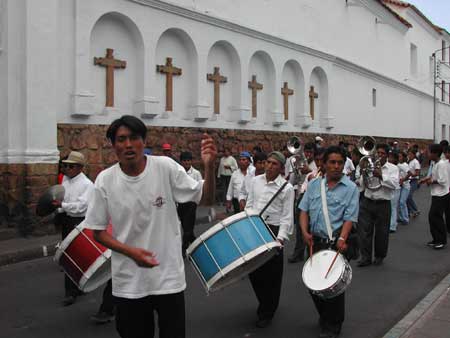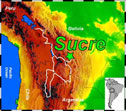|
Culture

Locals parading down the street (More Culture!)
|
Culture - Sucre
Sucre, located in central Bolivia in Eastern Cordillera, is the judicial capital of Bolivia! Although most government offices are in La Paz, Sucre was the original capital and remains the cultural center of the country.
"Sucre is a town apart in Bolivia. Whereas any other town in the country has unmistakable Incan influence, Sucre has a decidedly Spanish flavor. The Spanish white colonial architecture is a stark contrast to the austere appearance of typical Bolivian settlements." - Bobby Gillis
"The old buildings were quite grand with their fancy ornamentation and white paint." - Mary Kairouz
Sucre maintains traditional Bolivian markets, but has more shops and nice restaurants than other cities. Within the town square, tapestries, rugs, jewelry, and clothing line the sidewalks along with the eager merchants, willing to sell their goods away for very little cash. Many of us found that we bartered away more of our money then we actually thought - when everything costs so little, it seems we have a tendency to buy more. This is completely justifiable though - where else can you get a "Spaniards versus Incas" chess set?
Children serve as the majority of vendors, selling everything from postcards to chocolate bars. Five-year-olds insist on shining your shoes. As geologists, we were quite the attraction to them. We had the dirtiest shoes in town.
"One boy was only six years old, and he was covered head to toe in dirt. I asked him where his mother was, and he just giggled. Maybe my Spanish did not make sense." - Kristen Ebert
Traditional Bolivian (Quechuan) attire is worn around Sucre, though you will find many of the residents have moved into the jeans and t-shirts era. The Virgin of Guadalupe was celebrated while we were in town, and as a result, the town square was covered with people, parades, and brightly decorated cars. The cars were covered from trunk to hood in dolls, blankets, flowers, or any other random object you could imagine. The windshield was completely covered - leading us to believe that visibility wasn't too high. Watch out shoeshine boys. Pedestrians don't have the right of way in this city.
But parades do. In celebration for the Virgin of Guadalupe, the town square was temporarily blocked off as a wave of Bolivian teenagers and children came dancing and jumping down the street, living it up Bolivian style. This was an incredible scene, as hundreds of dancers came uniformly down the street, performing the same moves in sync.
Like modern cities today, bands and other entertainment come into the city to perform. We had the good fortune to witness MOLOTOV! - A Spanish-speaking "Mexican Beastie Boys" version of modern rock that made any gringo sit uneasy in their chair.
Our main activity during our stay in Sucre was a ride on the Dino-Truck, to see the Upper Cretaceous dinosaur tracks. This was probably our best opportunity to witness the culture throughout the city. We passed traditional to non-traditional homes, markets, discotecas, brightly colored murals, and the like. Eyes followed us in the Dino-truck as the drivers paraded us around the town for all the people to see.
|

